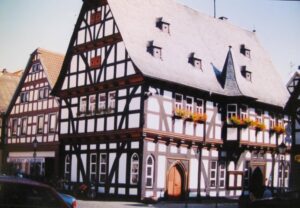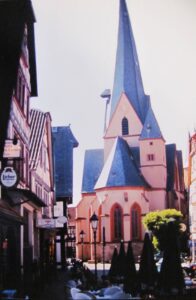Schotten, Germany: Land of My People
The town of Schotten is said to be the place of origin of both the Schott family and the Schott name sometime between the 11th and 13th centuries. The official history for the town of Schotten, Germany, is that an early document mentions a church “ad scotis” or “of the Scots” that is one of eight churches that Abbot Beatus bequeaths to the monastery Honau by Strasbourg. It is thought that this is likely to have been the first church in Schotten, which was built by Irish-Scottish monks.
This church probably grew, and by 1050, the first Roman Catholic church was built. Then, in the 1300s, the original Liebfrauenkirche (which was still in existence in 2001) was built in the town of Schotten.
A slightly more romantic version of this story is described in Johann Schott von Schottenborn’s 1587 family chronicle. [Quotes are from Sir Samuel Haslam Scott’s English translation.] This describes the origin of the village in 1015, when two Scottish princesses (Dickmunda and Adelmunda/Rosamunda) “founded at Wetter in the land of Hessen a nunnery.”
While the idea of Scottish (which may have actually been Irish) princesses wandering around 11th century Germany may seem improbable, there is evidence to support this. During a renovation of the church in Schotten in the 1700s, a parchment document dating from the 1300s was discovered which stated (in Latin): “anno 1015 after the birth of Christ in the reign of the King nicknamed the lame (Henry II, Emperor 1002 – 1024) two sisters from Scotia, one called Rosamunda, the other Dicmudis, began to build this town and our first church at Schotten.” There were also two wooden busts of these two sisters found in the church.
There were several “Schottenkirchen” (churches started by Scottish-Irish monks) in the Hessen area, all dependent on the mother church at Strasbourg. Florens, an Irish hermit, had been elected bishop of Strasbourg in 679. It’s likely that these two sisters were Irish, rather than Scottish, since Irish monks had been instrumental in spreading Christianity to the European continent, beginning with the work of St. Columban in 585.
(It’s also been speculated that these two sisters were the daughters of the Irish King Brian Boru, and that they fled to the European continent to do missionary work after the disastrous battle of Clontarf in 1014. However, there is nothing to substantiate this.)
According to Die Schottenchronik, the Schott family left Schotten in the late 12th or early 13th century and settled in other parts of Hessen.
Today Schotten is a modern town and well-known vacation spot for sports enthusiasts.
Sources:
Arnold, Friedrich E.G. Stammreihen der nassauisch-hessischen Familie Schott aus Eisemroth bei Dillenburg. Self-published, Hamburg-Blankensee, 1957. Available on microfilm 1181524, item 3, from the Family History Library in Salt Lake City. [This is one of the updates to Johann Schott von Schottenborn’s Die Schottenchronik. An incredible source of information on the village of Schotten and Schott family history from the year 1015 through the 1900s for many branches. This is primarily genealogical data with some written history, but shows all the Schott families that occupied Hessen through this time period. As you might guess from the title, it’s all in German.]
Cahill, Thomas. How the Irish Saved Civilization. Bantam Doubleday Dell Publishing Group, Inc. New York, 1995. [More about the Roman Empire and the Irish than Germany, but it does give some background on why those Irish missionaries would have been wandering around founding the town of Schotten, Germany.]
Pieper, Von Hartmann and J. Reinhardt Schott, Jr. “Die “Schottenchronik.” Published sometime after 1960. [This is another version of Johann Schott von Schottenborn’s family history—this one is based on the original manuscript, rather than the F.E.G. Arnold version, which was based on a copy. These authors make a lot of the fact that the early Schott family history is based on oral tradition, and can’t be verified in any way and therefore, should not be relied on. They also claim that their version is much more accurate than the F.E.G. Arnold version because it’s based on the original, not a copy. While I certainly found some discrepancies, I would say these are minor. These authors, however, have added to the original with information from other sources, which makes this version more complete overall.]
Scott, Sir Samuel Haslam of Yews. “An Old German Family History.” The Ancestor (London, April 1903).
Scott, Sir Samuel Haslam of Yews. A True Relation by Johann Schott von Schottenborn 1587. Translation by Sir Samuel Haslam Scott of Yews. Oxford University Press, 1929. [An incredible find—I had seen references to this English translation of the Johann Schott von Schottenborn document by an English branch of the family, but had no idea how to get my hands on a copy. I finally found it in an Irish bookstore through a rare book site on the Internet—and they were more than happy to sell this to me. This book/manuscript is the basis for all of the really early Schott family history and the theories about how the Schott name came into existence.]


Very interesting – thanks for posting!
Small world! My Volga Germans were from Schotten area. I was there in 2013. Interesting story.
Jean A. Roth Seattle
@Jean – that’s so cool! Wouldn’t it be funny if we were related way back when! 🙂
What an interesting article! My ancestors came from Ober-Seemen, Hessen (less than 12 miles from Schotten). I recently did DNA testing and was surprised to find that my haplogroup, R-Z253, is strongly associated with Ireland. Additionally, I have many Irish & Scottish genetic matches. I find it too strong a coincidence that my paternal ancestors came from a village less than 12 miles from Schotten and I carry an Irish y-haplogroup!
@Lee – that IS interesting! While my DNA didn’t show an extraordinarily high percentage of Irish, my paternal uncle’s did. Maybe for the same reason? 🙂
My mother’s maternal grandmother was born in Schotten. She came to New York City in 1885. We thought we had German mtDNA. My brother took an extremely detailed DNA test and it turns out our mtDNA is from the Hebrides Islands of Scotland. This means my Celtic ancestress traveled with the Ionian monks when they came to Scotten to found a monastery in the late 700’s. It also means that my maternal line did not leave Schotten from the late 700’s until 1885. Her name was Carolina Zimmermann. I once saw a picture of the mayor of Schotten online. His surname was Zimmermann and amazingly enough he looked very much like my brother.
@Gwenda – that is VERY cool! You’ll also want to make sure the paper trail of genealogical records backs that up, but what an interesting clue!